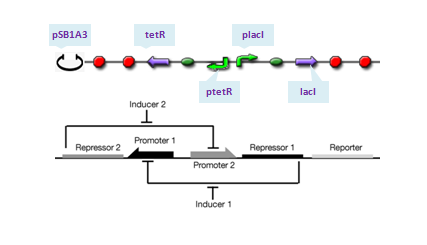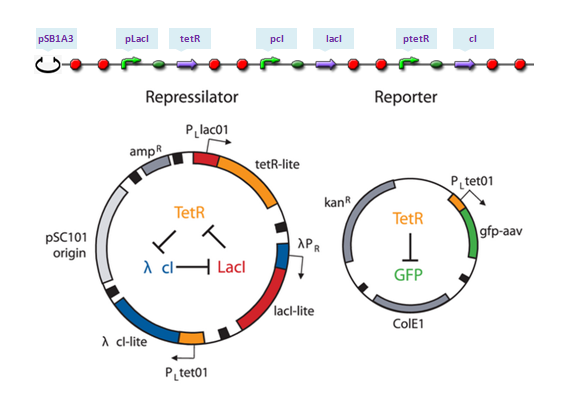|
|
| (94 intermediate revisions not shown) |
| Line 1: |
Line 1: |
| | {{Team:USTC_Software/Header}} | | {{Team:USTC_Software/Header}} |
| - | | + | {| cellpadding="15" cellspacing="0" |
| - | Using C-N Model we can model systems with great complexity
| + | |- |
| - | ==The simplest example with only E.coli cell==
| + | !|<font size="5">[[Team:USTC_Software/Transfer%20function%20of%20Part:BBa_F2620|pLux-LuxR repression system]]</font> |
| - | | + | !|<font size="5">[[Team:USTC_Software/Toggle-Switch|Toggle-Switch]]</font> |
| - | ===introduction===
| + | |- |
| - | As the simplest example, a model of a flask with only E.coli cells inside will be shown. Only one reaction will be considered: the replication of E.coli. However, it is not trivial. '''MoDeL''' enables users to add such an auto-catalytic replication reaction easily and conveniently. The minimal database used for this model could be download here.
| + | |valign="top"|[[Image:USTCs luxr gfp assembly.PNG|400px|thumb|center]] |
| - | | + | |valign="top"|[[Image:USTCs Toggle assembly.PNG|400px|thumb|center]] |
| - | ===database construction=== | + | |- |
| - | We only provide key points regarded with construction of this minimal database. To add the auto-catalytic reaction in the Reaction container, a species with only part E.coli is required. It has the simplest '''Chain-Node''' model format: only one chain with one part and no trees. The auto-catalytic reaction has one modifier and one product and they are both referred to E.coli defined in Species container. Since they are compartment-type species (species representing a compartment), attribute '''itself''' of '''compartmentLabel''' node in modifiers and products definitions should be set the same with label of the compartment they represent in the compartments definition. It ensures that the product and the modifier are the same, avoiding wrong mismatch of the product which is different with the modifier. Since number of E.coli cells will reach a stable level in a long time course, we use <math>k_{g}(1-C_{E.coli}/C_{max})C_{E.coli}V_{Flask}</math> as the reaction rate, where <math>k_{g}</math> is the growth rate of E.coli, <math>V_{Flask}</math> represents the size of E.coli, and <math>C_{E.coli}</math> and <math>
| + | !|<font size="5">[[Team:USTC_Software/Repressilator|Repressilator]]</font> |
| - | C_{max}</math> are concentration of E.coli and its max concentration in the flask, respectively. The negative sign in the rate equation indicates self-repression of E.coli cells.
| + | |- |
| - | | + | |valign="top"|[[Image:USTCs Oscillator assembling.PNG|400px|thumb|center]] |
| - | ===modelling and simulation=== | + | |} |
| - | Model written in '''SBML''' format is available here. The dynamic curve of E.coli replication is plotted by time course simulation:
| + | |
| - | | + | |
| - | ==Basic example with pLac-LacI repression system==
| + | |
| - | | + | |
| - | ==Demo of oscillator== | + | |
| - | ==Demo with reverse parts(Demo of toggle switch)==
| + | |
| - | ==Demo with environmental conditions== | + | |
| - | ==Demo with substituent transfers==
| + | |
| - | ==Demo with multi-compartment reactions==
| + | |
| - | ==Demo with complex binding product==
| + | |
 "
"


